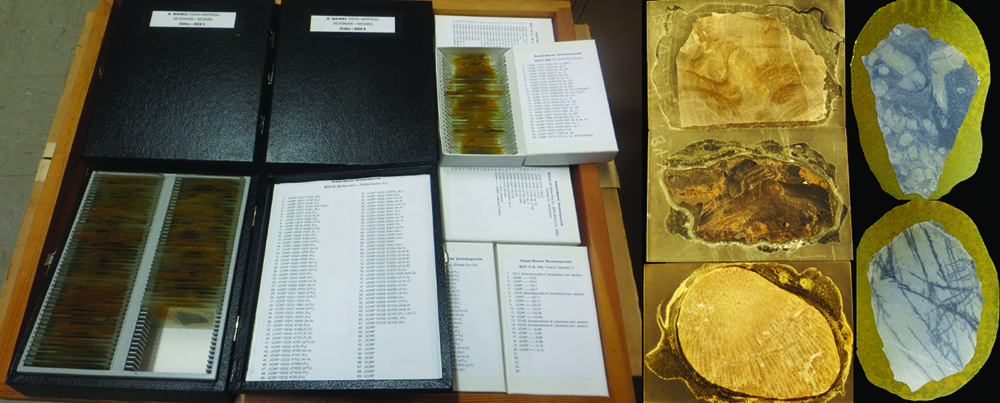
Russell H. Waines was a geologist who dedicated most of his life to ancient sponges, the stromatoporoids, which were one of the most important reef builders during the Paleozoic. When I was a graduate student researcher at the UCMP in 2013, I had the pleasure of organizing this collection (Figure 1), which includes approximately 2000 fossil specimens (566 of which are registered in the UCMP database) mainly from the Devonian of Nevada, but also from Alaska, Arizona, California, New York, Utah, Washington, the San Juan Islands, and Ontario. In addition to the fossil specimens, this collection has 910 slides (Figure 2) prepared by Waines during his dissertation work.
Russell Waines got his Ph.D. in Paleontology from UC Berkeley in 1965, under the supervision of J. Wyatt Durham. For his dissertation work, Waines performed a taxonomic study of the Devonian stromatoporoids from Nevada, which included four of the five stromatoporoid families: Labechiidae, Clathrodictyidae, Acrinostromatidae, and Idiostromatidae. He also revised the stratigraphic zones for the Upper Devonian and proposed a new zone using stromatoporoids as bioindicators.


Waines’ dissertation is a great monograph that includes a thorough morphological analysis of 30 stromatoporoid species with drawings of their cross-section (Figure 3). Impressively, 28 out of the 30 species analyzed by Waines were unknown to science and still are (Figure 4)! His dissertation was never published; therefore, the species described by him are not considered valid by the International Commission on Zoological Nomenclature. This collection is a great resource for stromatoporoid workers and if his species analyses were accurate, there are 28 new species in the UCMP drawers just waiting to be properly formalized.
Following his Ph.D., Russell Waines was hired by the New Paltz State University of New York where he retired in 2006. During his career, he published 13 scientific papers and 24 conference abstracts. His stromatoporoid works include:
Fritz, M.A. & Waines, R.H. 1956. Stromatoporoids from the Upper Abitibi River Limestone. Proceedings of Geological Association of Canada 8:87–126.
Waines, R.H. 1960. Stromatoporoids of the Kennett Limestone, Shasta County, California. Geological Society of America Bulletin 71(12):2081.
Langenheim, R.L., Jr.; Carss, B.W.; Kennerly, J.B.; McCutcheon, V.A. & Waines, R.H. 1962. Paleozoic section in Arrow Canyon Range, Clark County, Nevada. AAPG Bulletin 46:592–609.
Wilson, E.C.; Waines, R.H.; Coogan, AH. 1963. A new species of Komia Korde and the systemic position of the genus. Paleontology 6(2):246–253.
Waines, R.H. 1964. Devonian stromatoporoid faunas of Nevada. Geological Society of America Special Paper 76:230–231.
Waines, R.H. 1965. Devonian stromatoporoids of Nevada. Ph.D. dissertation, University of California, Berkeley. 505 p.
